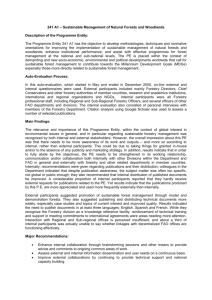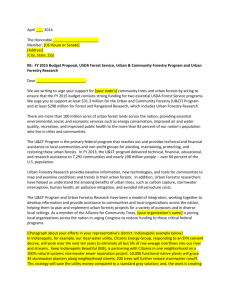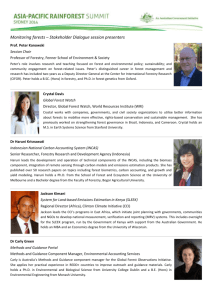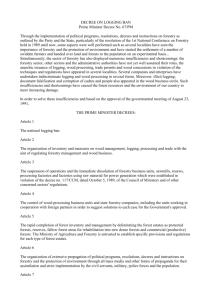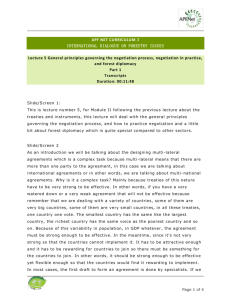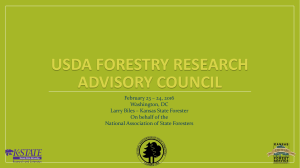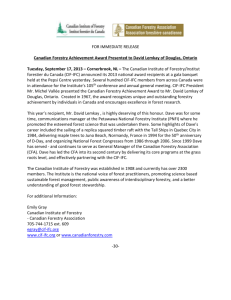Agroforestry and Sustainable Forest Management, Gregory Ruark
advertisement
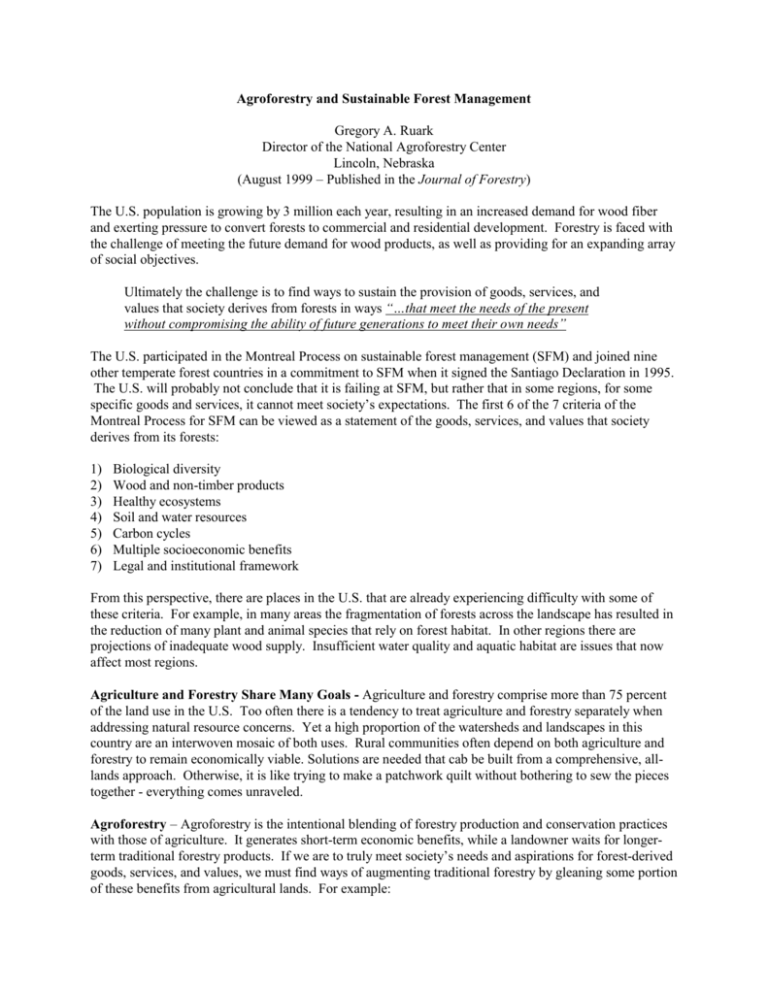
Agroforestry and Sustainable Forest Management Gregory A. Ruark Director of the National Agroforestry Center Lincoln, Nebraska (August 1999 – Published in the Journal of Forestry) The U.S. population is growing by 3 million each year, resulting in an increased demand for wood fiber and exerting pressure to convert forests to commercial and residential development. Forestry is faced with the challenge of meeting the future demand for wood products, as well as providing for an expanding array of social objectives. Ultimately the challenge is to find ways to sustain the provision of goods, services, and values that society derives from forests in ways “…that meet the needs of the present without compromising the ability of future generations to meet their own needs” The U.S. participated in the Montreal Process on sustainable forest management (SFM) and joined nine other temperate forest countries in a commitment to SFM when it signed the Santiago Declaration in 1995. The U.S. will probably not conclude that it is failing at SFM, but rather that in some regions, for some specific goods and services, it cannot meet society’s expectations. The first 6 of the 7 criteria of the Montreal Process for SFM can be viewed as a statement of the goods, services, and values that society derives from its forests: 1) 2) 3) 4) 5) 6) 7) Biological diversity Wood and non-timber products Healthy ecosystems Soil and water resources Carbon cycles Multiple socioeconomic benefits Legal and institutional framework From this perspective, there are places in the U.S. that are already experiencing difficulty with some of these criteria. For example, in many areas the fragmentation of forests across the landscape has resulted in the reduction of many plant and animal species that rely on forest habitat. In other regions there are projections of inadequate wood supply. Insufficient water quality and aquatic habitat are issues that now affect most regions. Agriculture and Forestry Share Many Goals - Agriculture and forestry comprise more than 75 percent of the land use in the U.S. Too often there is a tendency to treat agriculture and forestry separately when addressing natural resource concerns. Yet a high proportion of the watersheds and landscapes in this country are an interwoven mosaic of both uses. Rural communities often depend on both agriculture and forestry to remain economically viable. Solutions are needed that cab be built from a comprehensive, alllands approach. Otherwise, it is like trying to make a patchwork quilt without bothering to sew the pieces together - everything comes unraveled. Agroforestry – Agroforestry is the intentional blending of forestry production and conservation practices with those of agriculture. It generates short-term economic benefits, while a landowner waits for longerterm traditional forestry products. If we are to truly meet society’s needs and aspirations for forest-derived goods, services, and values, we must find ways of augmenting traditional forestry by gleaning some portion of these benefits from agricultural lands. For example: Shelterbelts can provide corridors across agricultural lands to connect forest fragments and increase wildlife benefits, while also protecting soils, crops, and livestock. Riparian forest buffers on farms and ranches can protect surface waters from sediments, nutrients, and contaminants, while enhancing aquatic habitats and sequestering carbon. Short rotation woody crops grown on farmlands can provide economic benefits for farmers while helping to meet the nation’s demand for wood fiber and energy. Farm woodlots can be used to grow specialty products like ginseng or mushrooms under a modified forest canopy, thereby encouraging timber stand improvement practices. Grazing/timber systems allow farmers to generate an annual income from grazing livestock under thinned conifer stands (> 50% light penetration) while producing high quality sawlogs. At the agriculture/community interface trees can be planted to provide social benefits and a buffer from agricultural activities and harsh environments. Sustainable Development - Many aspects of society are challenged by the need to develop sustainably. The really difficult challenge will be to find solutions that balance forestry with the sustainability of other sectors, like agriculture or communities. It is important that forestry criteria and indicators be in place to inform this debate. Since population and consumption continue to escalate, sustainable development is really an optimization problem whose solution is changing over time as communities strive to adapt to increasing pressures. For example: Suppose we find a forest owner who meets our criteria for sustainable forest management. Let’s give this owner an award! Great job! What if we return one year later and the forest has been cut and houses built. Before we can take umbrage with last years award recipient, he points out that he is still practicing sustainable development, only he has switched over to sustainable community work. Perhaps he is right. The greatest need for his community may have been additional housing and his forested tract may have resulted in the least detriments and most benefits. To have paved over adjacent prime farmland or filled in nearby wetlands may have been an even less desirable choice. The important point here is that in communities the pressure to develop will require that economic, social, and environmental benefits be weighed. SFM criteria can help insure that the trade-offs and consequences of various trajectories into the future are considered and clearly understood by communities. With more than 80 percent of Americans now living in urban or suburban environments it has become increasingly important that people understand that much of what they value is derived from forests. They need to understand that clean water does not just happen; that the materials they consume and the wastes they generate have associated consequences and responsibilities.

